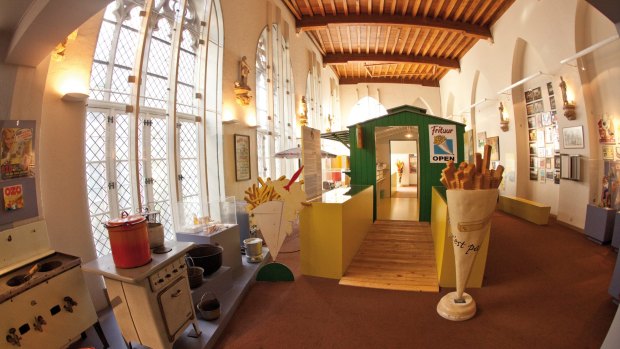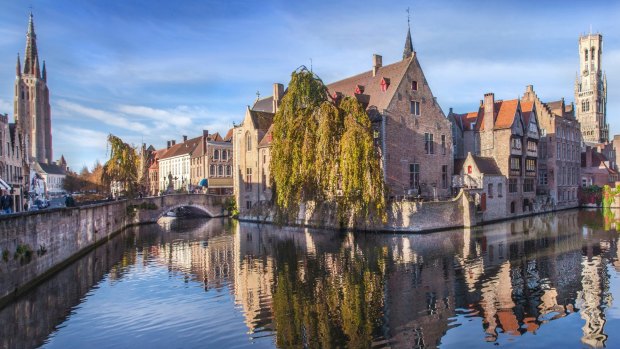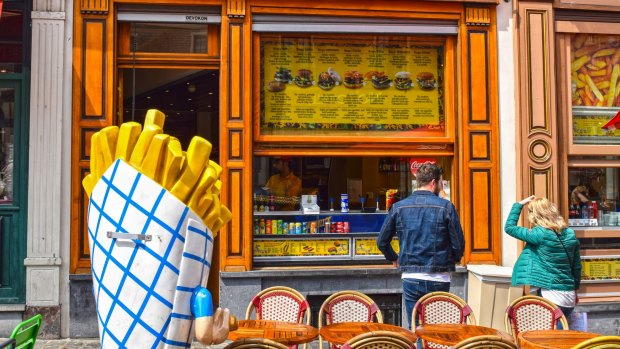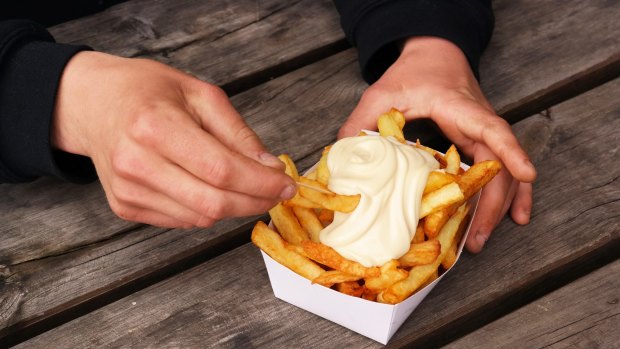This was published 6 years ago
Where do french fries originally come from? The Frietmuseum in Bruges reveals all

The Frietmuseum, a museum in Bruges, dedicated to showcasing the history of potatoes and the production of Belgian fries.
French fries did not, in fact, originate in France. Just ask the Belgians. They'll tell you. Historians have traced the origins of "les frites" back to Belgium, where they say villagers were getting their fry on as early as the 17th century.
At the Frietmuseum in Bruges, the self-proclaimed world's first museum devoted to fries, tough topics are tackled head-on. What is the secret of making good fries? Where does the potato come from? Is it OK to mix tomato sauce with mayonnaise?
With more than 300 years to perfect the humble hot chip, Belgium now reigns as the shining star of fried starch, the culinary capital of carbs. Statisticians estimate the annual consumption of potatoes at a whopping 85 kilos per Belgian. The other delicious food groups well-represented in the national diet – chocolate, waffles and beer – give some idea of the pleasure-seeking priorities in this part of the world.

Bruges, the capital of West Flanders in northwest Belgium.
Wherever you go in Brussels, Antwerp or Bruges, no-frills friteries can be found, serving hot, fried potato sticks for a few euros. Smothered with truffle mayonnaise, doused in spicy andalouse sauce or squished inside a sausage-filled baguette, they are the staple food of choice from dawn til dinnertime and beyond.
Now, thanks to Michelin-starred chef Sergio Herman, potatoes are posh. The Dutchman's inspiration for his chain of upscale cafes specialising in gourmet fries was simple. Since so many people already love chowing down on hot chips, it was time to respect the crispy snack and elevate it to a starring role.
Herman's battle cry might be: Respect the potato! It took him 18 months to find the right variety of spud, the Agria, a perfect blend of crisp on the outside and fluffy on the inside.

Belgian fries.Credit: Shutterstock
His Frites Atelier chain opened in 2016 to instant success and now boasts locations in the Netherlands and Belgium, where the restaurants in Antwerp and Ghent resemble trendy bars. The in-store soundtrack is curated by a celebrity DJ. With interior design that leans heavily on white marble, subway tiles and pops of bronze against charcoal paint, the cafes could be shops selling $90 candles.
Chefs in fresh whites sprinkle sea salt with a dash of finely chopped seaweed onto just-cooked fries. They fly out, whether served plain for the classicists or bathed in fresh sauces that range from the predictable – French Bearnaise, ketchup – to the decadent such as classic mayonnaise with shavings of rich truffle.
The seasonal menu features a changing roster of dishes, all built atop a pile of fries. Kimchi-loaded, or bearing the weight of a hearty Flemish beef stew, or mixed with the flavours of Indonesian satay, the fries are always the star. Something tells me low-carb diets won't be taking off in Belgium any time soon.

Wherever you go in Brussels, Antwerp or Bruges, no-frills friteries can be found, serving hot, fried potato sticks for a few euros. Credit: Shutterstock
TRIP NOTES
Kristie Kellahan travelled to Belgium as a guest of Visit Flanders. See visitflanders.com.
Etihad and Qatar Airways both offer one-stop flights from Sydney and Melbourne to Brussels. From there, Antwerp is a 30-minute train ride and Bruges is just under an hour. See etihad.com, qatarairways.com, raileurope.com.au
STAY
Hotel Rubens Grote Markt is in an ideal location, just steps from Antwerp Market Square on a quiet side street. The room decor blends luxe touches (velvet, marble and shiny bronze) with the comforts of home. See hotelrubensantwerp.be
In Bruges, Monsieur Ernest combines the cosy touches of a small lodge with the design sensibilities of a stylish international hotel. See monsieurernest.com
CARB LOAD
Restaurants, kiosks and vans serving fries are found everywhere in Belgium. For a delicious, fancy fries experience, seek out chef Sergio Herman's "frites ateliers" in Antwerp and Ghent. See fritesatelier.com
See also: Twenty reasons to visit Belgium
Sign up for the Traveller Deals newsletter
Get exclusive travel deals delivered straight to your inbox. Sign up now.